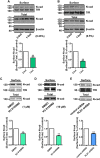PLD1 promotes dendritic spine development by inhibiting ADAM10-mediated N-cadherin cleavage
- PMID: 28729535
- PMCID: PMC5519554
- DOI: 10.1038/s41598-017-06121-2
PLD1 promotes dendritic spine development by inhibiting ADAM10-mediated N-cadherin cleavage
Abstract
Synapses are the basic units of information transmission, processing and integration in the nervous system. Dysfunction of the synaptic development has been recognized as one of the main reasons for mental dementia and psychiatric diseases such as Alzheimer's disease and autism. However, the underlying mechanisms of the synapse formation are far from clear. Here we report that phospholipase D1 (PLD1) promotes the development of dendritic spines in hippocampal neurons. We found that overexpressing PLD1 increases both the density and the area of dendritic spines. On the contrary, loss of function of PLD1, including overexpression of the catalytically-inactive PLD1 (PLD1ci) or knocking down PLD1 by siRNAs, leads to reduction in the spine density and the spine area. Moreover, we found that PLD1 promotes the dendritic spine development via regulating the membrane level of N-cadherin. Further studies showed that the regulation of surface N-cadherin by PLD1 is related with the cleavage of N-cadherin by a member of the disintegrin and metalloprotease family-ADAM10. Taking together, our results indicate a positive role of PLD1 in synaptogenesis by inhibiting the ADAM10 mediated N-cadherin cleavage and provide new therapeutic clues for some neurological diseases.
Conflict of interest statement
The authors declare that they have no competing interests.
Figures






References
Publication types
MeSH terms
Substances
LinkOut - more resources
Full Text Sources
Other Literature Sources
Research Materials

